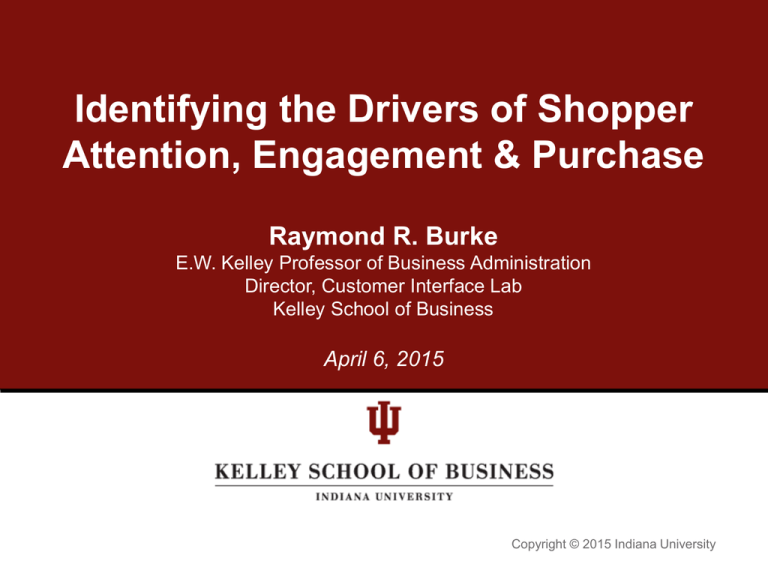Identifying the Drivers of Shopper Attention, Engagement & Purchase Raymond R. Burke
advertisement

Identifying the Drivers of Shopper Attention, Engagement & Purchase Raymond R. Burke E.W. Kelley Professor of Business Administration Director, Customer Interface Lab Kelley School of Business April 6, 2015 Copyright © 2015 Indiana Indiana University University Acknowledgements Alex Leykin Kelley School of Business Indiana University Bill Romollino and Jeff Gill Copyright © Indiana University 1.7 sec 41.5 % 7.19 sec 85.4 % 2.39 sec 61 % 1.81 sec 48.8 % 0.98 sec 19.5 % 0.23 sec 4.9 % 2.12 sec 70.7 % 5.19 sec 92.7 % The Retail Context • Shelves are packed with products • Consumers make decisions quickly • Information exposure is selective • Visual cues direct search Copyright © Indiana University What’s the Problem? Research Questions 1. What do shoppers “see” as they walk through the store aisles? What attracts their attention? 2. What affects shoppers’ ability to find what they want? 3. How can we turn browsers into buyers? 4. What role do salespeople play in influencing shopper behavior? Copyright © Indiana University Research Question #1 • What do shoppers “see” as they walk through the store aisles? What attracts their attention? Copyright © Indiana University 13 0 to 1 seconds 1 to 2 seconds 2 to 3 seconds 3 to 4 seconds 18 Tomato Shoppers Browsers Donut Shoppers Browsers Shopper Eye Fixation Duration (sec.) Endcap - Left Endcap - Right Checkout Lane - Left Over-the-belt Checkout Lane - Right Checkout Line Length Magazine Shoppers Browsers Magazine Shoppers Browsers Summary • Shoppers scan the visual field and rapidly decide if a product category or display is relevant • Shopper goals are critical in determining the breadth and duration of visual search • When shoppers are just browsing, a product’s shelf position, appearance, and presentation are key to engaging shoppers Copyright © Indiana University Research Question #2 • What affects shoppers’ ability to find what they want? Copyright © Indiana University Procedure • Experimental research using computer-simulated shelf displays • Manipulate target product and shelf display • Measure brand “findability” Copyright © Indiana University text target 9.42.5 seconds, 258fixations Finding Frosted Cheerios: target seconds, fixations Cheerios visual Finding Apple GoldenJacks: Grahams: 1.1 seconds, 5.7 seconds, 3 fixations 16 fixations Grahams Finding Post Bran Flakes: 2 shelf facings 2.1 3.3 seconds, 5 9 fixations Flakes 4 messy shelves Finding Golden Grahams: shelves8.2 5.7seconds, seconds,20 16fixations fixations Grahams straight Research Question #3 • How can we turn browsers into buyers? Apparel Shopping “For men, it's about… getting in there, getting what they need, and then getting the hell out” Copyright © Indiana University ? Results • 85% increase in product touch • 44% increase in unit sales • 38% increase in dollar sales Copyright © Indiana University Research Question #4 • What role do salespeople play in influencing shopper behavior? Example: Analyzing the impact of salesperson comments on purchase conversion Copyright © Indiana University Procedure • Store sales associates were asked to wear concealed microphones to record their conversations with shoppers • At the completion of each shopper’s store visit, the number of items purchased was recorded • Audio recordings were transcribed and content analyzed • Each element of the conversation was coded into one of thirteen categories Copyright © Indiana University Results • Salesperson Interaction (specialty apparel) • • • • • • • • • • • • • Asks question to open conversation/assess needs (80%) Asks question to offer assistance (63%) ASSISTANCE Promises to assist customer (6%) Requests assistance from other associate (9%) Provides product information (59%) Recommends product, style, or size (15%) PRODUCT Describes own experience with product (15%) INFORMATION Expresses personal opinion (26%) Shares opinion of other customers (11%) Suggests different product, style, or size (22%) Personalizes conversation through small talk (9%) OTHER Suggests customer try on product (26%) Copyright © Indiana University Suggests customer order product online (13%) Results (cont.) • Salesperson Interaction: High frequency comments • • • • • • • • • • • • • Asks question to open conversation/assess needs (80%) Asks question to offer assistance (63%) ASSISTANCE Promises to assist customer (6%) Requests assistance from other associate (9%) Provides product information (59%) Recommends product, style, or size (15%) PRODUCT Describes own experience with product (15%) INFORMATION Expresses personal opinion (26%) Shares opinion of other customers (11%) Suggests different product, style, or size (22%) Personalizes conversation through small talk (9%) OTHER Suggests customer try on product (26%) Copyright © Indiana University Suggests customer order product online (13%) Results (cont.) • Salesperson Interaction: High conversion comments • • • • • • • • • • • • • Asks question to open conversation/assess needs (80%) Asks question to offer assistance (63%) ASSISTANCE Promises to assist customer (6%) Requests assistance from other associate (9%) Provides product information (59%) Recommends product, style, or size (15%) PRODUCT Describes own experience with product (15%) INFORMATION Expresses personal opinion (26%) Shares opinion of other customers (11%) Suggests different product, style, or size (22%) Personalizes conversation through small talk (9%) OTHER Suggests customer try on product (26%) Copyright © Indiana University Suggests customer order product online (13%) Conclusion • New research tools allow merchants to identify the factors that drive shopper attention and purchase, as well as the points of friction in the shopping process, and create store environments that better connect with shoppers’ needs and desires • Small changes to the shopping environment can have a powerful impact on shopper engagement and purchase conversion Copyright © Indiana University Looking Ahead… • Mining in-store video to identify the drivers of shopper engagement and purchase conversion • Linking shoppers’ in-store experiences with perceptions of store shoppability, trip satisfaction, and store loyalty • More detailed analysis of shopper ergonomics and the interaction with displays and products Copyright © Indiana University Resources Questions? rayburke@indiana.edu Indiana University’s Kelley School of Business www.kelley.iu.edu Copyright © Indiana University Shopper Research Insights from the Kelley School’s Customer Interface Lab…





